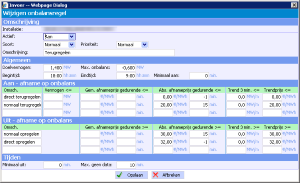Introduction
ENetControl is a central application that bridges the gap between the energy trading platform [ENet](../ enet/) and the physical infrastructure. The ultimate control of the physical infrastructure is done decentralised, by a RMC.
History
Initially, the RMC was controlled directly from ENet. When more and more functionalities were being added, we decided to separate it into an independent application in 2008.
Functions
Link with ENet
- ENetControl receives an energy program from [ENet](../ enet/) for each controlled installation
- ENetControl converts measurement data into connection allocation data. It sends these every PTE to ENet
Calculating control schemes
To minimise the imbalance, the received installation energy programs are converted into operating schemes per installation, which take into account the specific installation properties. These control schemes are sent to the RMC.
Imbalance prediction
An imbalance price prediction is made on the basis of the delta signal and the bid price ladder published by Tennet.
Imbalance control

By helping Tennet balance the electricity grid by deliberately creating imbalance in the other direction, money can be made. In ENetControl, customers can set rules when they want to deviate from the energy program and thus create deliberate imbalance. ENetControl subsequently makes changes to the control scheme. The changes are made in such a way that if the internet connection is lost, the RMC reverts to the original schedule.
Energy meter
The data from energy meters that comes in from the [RMC](../ rmc/) is stored in ENetControl. Electricity is stored per minute as standard, gas and heat per five minutes. ENetControl also supports calculated energy meters. The value of the energy meter is then calculated from the other energy meter on a distributor. This data is used for graphs and the upload to ENet.
Data communication RMC
ENetControl maintains continuous connection with all RMCs in the field for the exchange of data such as control schemes, measurement data, Linux syslog and time synchronisation. For this, it uses its own protocol that deals with UDP.
Technologies
C #, SQL Server 2000, Transact-SQL, HTML, CSS, JavaScript, SilverLight, Edine, Edifact, XSLTransforms
Production
2008 - 2015
My function
Developed it myself in its entirety. From functional design to software development.